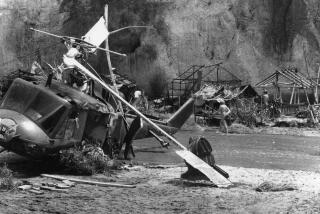Picture of Dedicated Marine Emerges at Hearing on Joy Ride
- Share via
Throughout the first day of proceedings against Lance Cpl. Howard A. Foote Jr., charged with taking a $14-million fighter plane on a joy ride at El Toro Marine Corps Air Station, it was difficult to see where the prosecution ended and the defense began.
Both prosecution and defense witnesses at Friday’s hearing painted a nearly seamless portrait of a highly motivated and well-liked young man who, buckling under the weight of a broken dream, “had to fly, at least one time.”
Ambitions Were Dashed
The 21-year-old aviation mechanic and record-breaking glider pilot faces five related charges growing out of an unauthorized, late-night flight of an A-4M Skyhawk last July 4. Before the plane was taken, the Los Alamitos native had learned that a blood ailment caused by an attempt to break a glider altitude record had, in all likelihood, put an end to his ambition of becoming a jet pilot.
If convicted, Foote faces a sentence of four years in prison, although centuries-old naval law holds out the technical possibility of a death penalty. The Marine Corps is a branch of the Navy, and malicious or grossly negligent destruction of a vessel is still a capital crime under old maritime law.
During the Article 32 hearing--the military equivalent of a preliminary hearing and a grand jury inquiry--the prosecutor, Capt. Jett L. Whitmer, called six witnesses, and their testimony went largely unchallenged during cross-examination by the defense counsel, Capt. Bradley N. Garber.
Heard Taxiing Jet
Prosecution witnesses had complimentary things to say about Foote, and some of his strongest character references came from past and present Marine officers.
Lance Cpl. Brenda Mueller, the sentry in charge of the area where the plane was hangared, testified that, while heading for an authorized break shortly before 2 a.m., she heard the sound of a jet engine taxiing onto the closed field.
“That’s what clued me that there was something wrong,” she said.
Mueller testified that about 10 minutes before the plane was started she saw a yellow truck driven into the area. Since such vehicles were common in the area, “it caused me no reason to be suspicious,” she said. The truck had its lights on, was observing the speed limit and not moving erratically, Mueller said.
Mueller said she pursued the plane on foot and, although authorized to draw her pistol, did not fire, because by then “the target was too small” and she “did not have an accurate shot.”
Since the field was closed, the plane was not tracked on radar and no other aircraft were sent to pursue it during the hour or so that Foote was airborne. He reportedly traveled about 50 miles.
Requesting Illumination
Before landing, Foote made five passes at the runway. Another sentry and prosecution witness, Cpl. William R. Graham, testified that he assumed that Foote was not “buzzing” the darkened runway but attempting to have the lights turned on in order to make a safe landing. The lights eventually were turned on.
Maj. Frank B. Kennedy III, an aviation maintenance officer, recalled being awakened around 2 a.m. and being told that “we didn’t have as many aircraft as we were supposed to.”
By the time he got to the base, Kennedy testified, Foote had landed and the plane was surrounded by military police officers with drawn .45-caliber pistols.
Kennedy said that he asked Foote, after he climbed out of the cockpit, whether he had had a good flight. “He informed me that he thought we had a generator problem with the engine,” Kennedy said.
Kennedy testified that “from a maintenance standpoint, it was not a flyable airplane.” Earlier the previous day, Kennedy had flown the plane and found that the aileron rigging was out of alignment and the nose wheel steering mechanism was not working properly.
Inspecting the aircraft after Foote was taken into custody, Kennedy found only minimal damage to the single-seat fighter, he said. From one gauge, he determined that Foote had undergone considerable gravitational pressure before landing the plane, including a brief period of weightlessness.
Wouldn’t Ride Along
Kennedy characterized Foote’s feat as “kind of impressive, in the middle of the night.” But, he added, despite the mechanic’s glider experience and training on the base’s flight simulator, “I sure wouldn’t want to ride with him.”
Friday’s proceedings were held just below an old control tower now used primarily as a sentry post. During the hearing, Foote sat stiffly next to Garber, occasionally whispering to his attorney. Although the small room is lined with acoustical tiles, testimony was frequently drowned out by the sound of screaming jets.
“This is a bad place for a courtroom,” Kennedy said during one pause.
Among the documents offered by Garber as evidence on Foote’s behalf, were:
- A letter of commendation from Marine Corps Commandant Gen. Paul X. Kelley, congratulating the mechanic on his efforts to break the altitude record in his glider.
- A request to Kelley from former El Toro Commanding Gen. William A. Bloomer, who, along with Foote, used to fly his own glider, asking for Marine Corps support of Foote’s latest record-breaking effort.
- A letter from the commanding officer at the brig at Camp Pendleton where Foote has been held, noting that the Marine had maintained “a good and positive attitude” while in custody.
The defendant’s parents, Howard P. and Shirley R. Foote, who now live in Palm Springs, testified about their son’s growing dedication to aviation, beginning with his interest in building model airplanes.
Flying Was Goal
Foote’s mother said that her son’s interest in flying gliders with the Long Beach Soaring Club in Los Alamitos motivated him to become a conscientious student, taking difficult courses he thought would be necessary to become a military aviator.
“He was very determined,” she testified. From the age of 15, flying dominated his life to the exclusion of almost everything, including sports, she said.
Flying, Shirley Foote said, “really wasn’t a sport; it was his life.” Her son was never in trouble with the law, she said, and never had so much as a traffic ticket.
After graduating from high school, Foote joined the Marines, hoping to earn a college degree and become an officer, both prerequisites to a flying career. In early 1986 he learned from a flight surgeon that a blood embolism caused by a high-altitude glider flight--a condition similar to “the bends” suffered by underwater divers-- would probably prevent him from being accepted into a flight training program.
“He was very, very depressed,” Shirley Foote said. “He was devastated.”
Asked by Garber why he thought the young man took the plane, Foote’s father, a retired Rockwell engineer who once worked on the Space Shuttle program, said, “He had to fly, at least one time.”
Neither of Foote’s parents were cross-examined by the prosecution.
The hearings are scheduled to continue on Tuesday.
More to Read
Sign up for Essential California
The most important California stories and recommendations in your inbox every morning.
You may occasionally receive promotional content from the Los Angeles Times.










